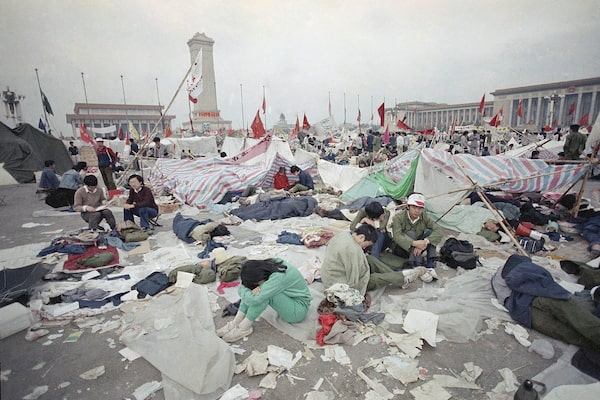Frank Ching is a Hong Kong-based journalist.

Students rest in the litter of Tiananmen Square in Beijing on May 28, 1989, as their strike for government reform enters its third week. A quarter century after the Communist Partys attack on demonstrations centered on Tiananmen Square on June 4, 1989, the ruling party prohibits public discussion and 1989 is banned from textbooks and Chinese websites.Jeff Widener
For many Chinese people, numbers have tremendous meaning. Four, for instance, is to be avoided at all costs, as it sounds like “death” in Cantonese; six brings luck. And because nine sounds like “long-lasting,” it represents longevity, especially at birthdays and weddings.
That’s appropriate, given the Chinese tradition of looking into its long history to learn lessons and avoid repeating mistakes. But 2019 also represents a timely opportunity to examine how modern China has been forged, in many ways, by the historical events that happened in years that end in the number nine.
A hundred years ago, in 1919, world leaders met for the Versailles Peace Conference, which brought a formal end to the First World War. But while the Chinese Republic was on the side of the victorious Allies, having contributed 140,000 labourers to the cause, Britain, France, the United States and Italy agreed that the German colony of Shandong would not be returned to China, and instead transferred to Japan. In what would be called the May Fourth movement, thousands of students gathered in Tiananmen Square. The initially orderly protests turned violent, and several officials were beaten up and their homes burned down.
These 1919 events morphed into the new culture movement, which saw intellectuals examining the social reasons that made China weak as a nation; author Chen Duxiu, for instance, called for the jettisoning of “Mr. Confucius” in favour of “Mr. Science” and “Mr. Democracy.” Amid this intellectual ferment, Mr. Chen and other revolutionary leaders founded the Communist Party of China in 1921, promising democratic rule if it gained power.
By 1949, Mao Zedong had announced the formation of the People’s Republic of China, and by the end of the year, the CPC had become the major ruling party. But despite its vow, it created a monopoly on power, nixing the legal profession and the independent judiciary.
In 1959, New China commemorated its first decade by unveiling the 10 Great Buildings in Beijing. But it also marked the first year of the Great Chinese Famine, in which tens of millions of people starved to death at least in part because of the Communist Party’s misnamed Great Leap Forward – a tragedy the West largely overlooked. That same year, China crushed an uprising in Tibet, forcing the Dalai Lama into his long exile in India.
The year 1969 brought about a military border conflict with the Soviet Union, with the Sino-Soviet split over doctrinal differences hitting a fever pitch. This paved the way for a rapprochement with the United States in the 1970s, with then-president Richard Nixon visiting China in the early part of the decade. In 1979, China and the United States formally established diplomatic relations, marking the beginning of China’s “reform and opening up” drive, which resulted in rapid economic development.
A decade after the start of those diplomatic relations, outrage over corruption sparked demonstrations in Tiananmen Square in the spring of 1989, with students calling for democracy. Troops brutally put down the uprising, which resulted in a major downturn in the U.S.-China relationship as Western countries imposed sanctions on China. Still, its economic reforms continued, with stock markets opening in Shanghai and Shenzhen.
In 1999, China’s relations with Taiwan took a nosedive after an interview in which Lee Teng-hui, the island’s first popularly elected president, described the relationship as “state-to-state” or at least “special state-to-state.” Beijing would cut off all dialogue with Taiwan for nine years.
And by 2009, Beijing had been fully integrated into the global economy. The financial crisis in the West resulted in 20 million migrant workers in China being laid off that year. That same year, China worked to ensure its resource security, making its largest-ever investment in a foreign company – state-controlled Chinalco’s US$19.5-billion agreement with British-Australian mining firm Rio Tinto – and opening a new gas pipeline between China and Turkmenistan.
So 2019 becomes a year for the world to watch in China. Last month, President Xi Jinping pledged that China would work with others “to build a lasting peace, common security and common prosperity,” but this will not be easy. China first will have to win the trust of other countries – and given its track record both at home and abroad, this will require patience and hard work.
Domestically, the forced incarceration of the Muslim-minority Uyghurs and the government’s crackdown on religion, human-rights lawyers and activists have made it the target of the West’s ire. The world will remember the way it bullied South Korea over the latter’s installation of the THAAD anti-missile system; China has also detained two Canadian citizens, apparently as punishment for the arrest of a Huawei executive as a result of a U.S. extradition request. These actions render China’s promises of supporting the international rule of law hollow.
The Chinese government should take note: China isn’t the only country that has a long memory and uses history as a mirror.